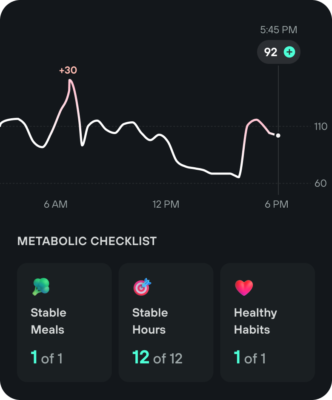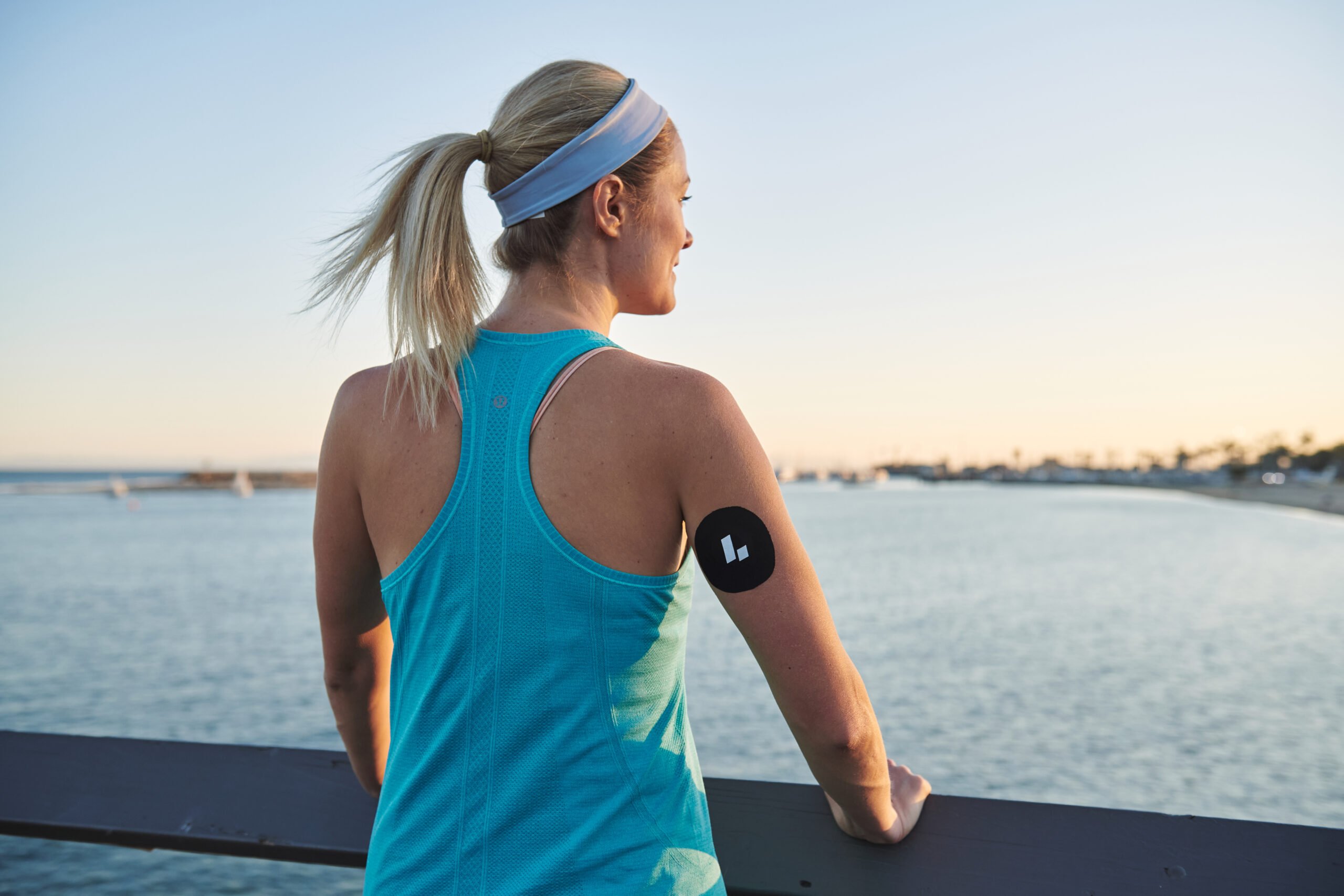With more nutrition advice than ever floating around, it can seem impossible to figure out what approach to your diet will work for you. In fact, 59% of people say that conflicting information about nutrition makes them doubt their food choices. On top of that, our bodies can seem like black boxes. Often, we don’t know a diet affects our health until it’s time for an annual blood test—which may be months after implementing a dietary change.
What we need is a way to see how the food we eat (and the context in which we eat it) affects critical body systems in real-time. Fortunately, there is a tool that can provide that kind of closed feedback loop, allowing us to watch our body respond to our meals and home in on our ideal diet right now. It’s called a continuous glucose monitor, or CGM.
Initially developed for people with diabetes—who need to meticulously measure their blood sugar so they can adequately dose insulin—CGMs are now commonly used by anybody seeking a better understanding of their metabolic health. (Metabolism just refers to how your body makes and uses energy, and glucose is one of your body’s primary energy sources.)
Even among all the advanced wearables out there today, there are two magical aspects of CGM:
- It shows you what’s happening inside your body. That’s a view we seldom get, except in annual blood tests. The CGM measures glucose concentrations under your skin as a proxy for what’s circulating right now in your blood. And since glucose powers all the cells in your body, CGM allows you an incredible glimpse into your body’s current condition. There are no other molecules we can currently measure this way.
- It’s continuous and real-time. Standard glucose tests show you a single point in time. But CGM shows you the curve of a full day, as well as trends over days and weeks. This is an exponentially higher resolution picture of your body’s energy systems at work and allows you to truly match choices with data.
These two features make CGM a powerful tool for finding the diet that works best for your body. Here are some specific things you can learn and what CGM can’t solve.
What CGMs Can Tell You About Your Diet
Glucose, or blood sugar, is a primary energy source we take from food (along with fat). When our body’s glucose processing system is awry, our cells can’t efficiently make and use energy, leading to several adverse health consequences. Maintaining stable blood sugar levels is crucial to improving health through diet.

More jagged peaks in your glucose curve represent frequent blood sugar spikes—when your body is trying to deal with an overload of glucose—and the subsequent crashes that are often the aftermath of a sharp rise.
1. Which foods help your body function at its best
It’s natural for your glucose levels to rise and fall as you eat, sleep, and move through your day. This change is called glycemic variability. To build optimal health, the goal is a glucose curve that looks like gently rolling hills, not jagged mountains. These spikes and crashes are the root of the various health consequences of metabolic dysfunction. In the short term, they can cause fatigue, brain fog, and irritability; in the long term, they contribute to several chronic diseases, including Type 2 diabetes, cardiovascular disease, and Alzheimer’s.
What CGM provides is a way to see right away how much glycemic variability a given meal causes for you. Glucose response to food is highly individual—what spikes you may not spike me, so just reading carb counts on labels or looking at a glycemic index isn’t enough information to make personalized, informed decisions. Only a CGM can give you objective data.
The Levels app lets you log your meal and then see your glucose response as measured by the CGM—how high your glucose went and how long it took to come back down. It even tracks how different meals performed, so you can understand what works and what doesn’t.
Accurate, objective data like this helps you cut through all the marketing and diet hype and focus instead on your body’s needs.
2. How other choices impact your body’s response to a food.
Food affects different people in different ways: while carrots might be a great source of energy for you, they might send my glucose levels soaring. Moreover, even within a person, the same food can lead to different responses at different times. That’s because how your body uses the food you eat isn’t an isolated process—it’s affected by everything else happening in your body and several other factors, including:
- Exercise, like walking after a meal (which can blunt a glucose spike) or how hard you worked out today (or didn’t!)
- Sleep: Being sleep-deprived can worsen glucose control
- Stress can spike your blood sugar independent of food or worsen your body’s glucose response
- Food timing: Our bodies’ response to food is tied to our circadian rhythms; for example, your body can process glucose better in the morning than at night
- Food order: Eating carbohydrates after fat and protein can blunt glucose spikes
- Hormones: For women, monthly changes in hormone levels can impact how your body handles glucose
Using a tool like Levels alongside a CGM allows you to pair these other factors with a food log to give you a complete picture of your body’s glucose curve.
For example, you may find that eating sushi produces a sharp spike (the rice will often do that). But a week later, you may have sushi again after a great night’s sleep and with a walk right after and find that your glucose rise is only half as high.
Learn more:
3. How your body’s energy system functions over time
Because CGM gives you this continuous, ongoing picture of your glucose as long as you’re wearing one, it can help you spot long- and short-term trends and adjust your diet accordingly. For example, perhaps you notice a significant spike in glucose followed by a dramatic plummet every morning; as an experiment, you replace your “healthy” oatmeal with an omelet and observe no spike and crash. This data nudges you to drop your cereal habit altogether.
As you continue adjusting your diet, you may notice more significant changes over weeks and months. That’s because eliminating regular spikes not only improves your blood sugar for that day but, over time, can improve your overall metabolic health. With a CGM, you don’t have to wait for that next blood test to see if this change helped; you can watch it in your long-term trend data.
What a CGM Can’t Tell You About Your Diet
Glucose response is a critical component of metabolic health, but it isn’t the only thing that matters in our diet. You could drink canola oil and vodka all day and have a stable glucose line, but that would quickly cause a lot of other damage in your body.
Here are some essential features of diet that a CGM can’t tell you:
1. Whether you’re eating enough micronutrients, fiber, and antioxidants.
- Micronutrients are the magical molecules that power thousands of reactions in our body, from hormone signaling to gene expression. Eating a colorful, whole-food diet is the best way to ensure you get everything you need.
- Fiber—found in whole fruits and vegetables—feeds the critical gut microbiome, which influences everything from your immune system to your metabolic health. Fiber also helps keep inflammation down and improves glucose and insulin.
- Antioxidants help repair cellular damage called oxidative stress that can drive diseases like cancer and diabetes. Foods like cold-water fish and cruciferous veggies are excellent sources.
2. How your food affects your insulin levels.
Insulin is a critical hormone that, among other things, helps shuttle glucose out of your blood and into cells, where it can become energy. High glucose can lead to increased insulin, which can cause a cascade of health problems. Glucose is a good proxy for insulin, but it’s not perfect. Some foods, like dairy, can cause an insulin surge even without a big glucose load.
3. What you can and can’t eat.
A CGM paired with an app like Levels is a tool to help you find the diet that helps you feel better day to day and builds long-term health. Just because a food produces a high glucose response doesn’t mean you can never eat it. If you decide to have one of mom’s famous cupcakes when she visits, the CGM can help you add strategies to minimize the effects, like eating some protein first and exercising after. It can also help you get back on track quickly and give feedback that your long-term trends are still doing great.
Conclusion
CGMs are the best tool for seeing how your diet impacts your health in real-time. Using one, even for a few weeks, can give you invaluable objective data that can empower you to make the choices that work best for you.











